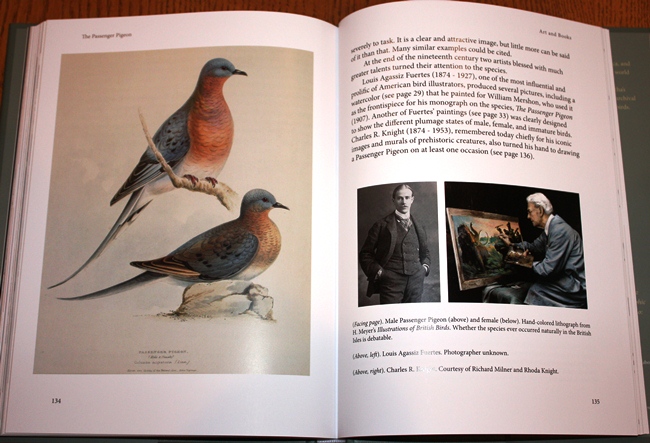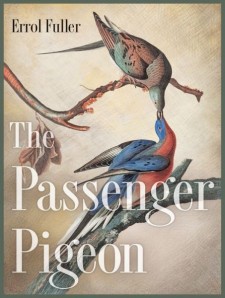Reviewed by Grant McCreary on October 28th, 2014.
If you weren’t aware of the Passenger Pigeon before this year, chances are you are now. 2014, as the 100th anniversary of its extinction, saw newspaper articles, documentaries, Project Passenger Pigeon, and, of course, multiple books concerning this bird. In one of those books, simply titled The Passenger Pigeon, Errol Fuller tells the story of this bird, “a tale that has everything: great drama, tragedy, intrigue, violence, mystery.”
The tale starts with the bird itself. Fuller recounts what is known about the pigeon’s natural history, including its taxonomy, range, nomadic tendency, nesting, and vocalizations. There are some interesting things here, such as the fact that recent DNA analysis shows that the Passenger Pigeon’s nearest relatives were the pigeons of the Patagioenas genus, which means that they were more closely related to the Band-tailed Pigeon than the Mourning Dove, counter to the bird’s physical similarity to the latter. One of the odder things included in the book is a series of musical notations representing various sounds produced by the pigeons, written down by an observer of the last living individuals in a captive flock. Since there are no recordings of the pigeon, these, along with their associated descriptions, are the closest that we’ll get to hearing it.
Much of the narrative, unsurprisingly, is dedicated to the bird’s “downward spiral” and extinction. But just as interesting, and much less familiar, is a lengthy examination of the Passenger Pigeon in captivity. There were two captive flocks at the turn of the twentieth century that enjoyed moderate success at breeding. It was enlightening to see how the owners, essentially hobbyists, kept the birds, but frustrating as well because it shows that there was a good chance that if a concerted, organized, professional captive breeding attempt had been made there is a good chance it would have worked.
The most famous captive pigeon was Martha, the last surviving Passenger Pigeon that lived in the Cincinnati zoo, and she has an entire chapter devoted to her. The author recounts what (little) is known of her life and death, and a good bit more about what happened to her after she died.
Fuller has written several books on extinct birds and other animals, so he is keenly aware of the primary problem with any such book, namely, that “when stripped of pretension or supposition dressed up as fact, it can only really be a compilation of the work of those who have gone before.” That is pretty much the case here, as well. But Fuller doesn’t try to hide that and does his best to keep it interesting, even for those who know this story well. However, there is one way in which this book adds immeasurably to the story – art.
The Passenger Pigeon is profusely illustrated, and I greatly appreciate the diversity of art that is included. Many readers will already be familiar with the most famous portrait of Passenger Pigeons, that by John James Audubon (which graces this book’s cover). But Fuller also includes many other works, from the earliest published image of the bird by Mark Catesby (around 1731-1743), to modern-day. This includes art from well-known individuals like Alexander Wilson and Louis Agassiz Fuertes, as well as obscure. Much of it is traditional portraits, but there are some more odd works as well, such as Sara Angelucci’s images of Passenger Pigeon features morphed with those of humans. There’s even an enormous mural of a pigeon flock on the side of a building in Cincinnati, close to the zoo that housed Martha (I’ve got to see this one day).

Fuller does more than simply display the art, he also analyzes it. My favorite chapter in The Passenger Pigeon is ‘Art and Books’, in which he chronicles the Passenger Pigeon’s appearance in these media. His evaluation of the art is brutally honest. Most of the nineteenth century depictions are “characterized by their stiffness and the mediocre draftsmanship exhibited.” The author seems to be more impressed with some of the more modern works than I am, but his assessment of Audubon is, in my opinion, right on. He points out that many commentators on Audubon’s Passenger Pigeons (and other works) “have sought to downgrade it over a supposed lack of accuracy in the story it tells.” True, some of the particulars are not accurate. For example, if food was passed between birds it would be given by the male to the female (the opposite of what Audubon depicted). But such “pedantic analysis” misses the point. As Fuller points out:
It is quite simply a graphic image of the highest order, with an immediacy that strikes instant emotional notes in the viewer. Its visual grace and wonderful flow in terms of composition and subtlety of coloring are made all the more poignant by the fact that the species (unlike the image) no longer exists.
There’s not just art, the book contains many photographs as well. A remarkable number of them are of live Passenger Pigeons. Some of these, pictures of both Martha and a captive flock housed elsewhere, were previously published in Fuller’s Lost Animals: Extinction and the Photographic Record, but many more are included here.
The Passenger Pigeon closes with an out-of-place appendix by Julian Pender Hume that details the bird’s anatomy. It’s interesting, showing how this pigeon was built for powerful flight, but it’s much more technical than the rest of the book. Perhaps this would have fit better in Hume’s own book on extinct birds? Still, I won’t complain about the inclusion of more information.
Recommendation
The Passenger Pigeon is an excellent introduction to this bird, what made it so special, and the tragedy of its extinction. If you want to learn about the Passenger Pigeon, or just enjoy the art and photographs, then I’d highly recommend it. Afterward, if you’d like to delve deeper into the subject, you can continue with A Feathered River Across the Sky: The Passenger Pigeon’s Flight to Extinction.
Disclosure: I get a small commission for purchases made through links in this post.
Buy from NHBS
(based in the U.K.)
Disclosure: The item reviewed here was a complementary review copy provided by the publisher. But the opinion expressed here is my own, it has not been influenced in any way.






[…] review for The Guardian Grant McCreary’s review for The Birder’s Library Adrian Barnett’s review for New Scientist Donna’s review for 10,000 […]